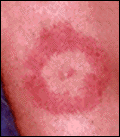BI160: Development of Vaccines to
Infectious Diseases


SIGNS AND SYMPTOMS
Lyme disease typically presents in three distinct stages. Each stage is characterized by different signs and symptoms.
Stage One - Early Localized Infection
Stage one disease symptoms occur within 1-30 days after being bitten by the deer tick, Ixodes Scapularis or Ixodes Pacificus. In this stage the pathogen, Borrelia burgdorferi, begins replicating in tissues adjacent to the site of initial infection.
 |
| Erythema Migrans (EM) |
Signs and symptoms include:
- Erythema Migrans
- Myalgia
- Arthalgia
- Headache
- Fever
- Nucal Rigidity
Erythema Migrans (EM) is the most common symptom, occurring in as many as 75% of patients.
It is considered pathognomonic for Lyme Disease. Lesions are circular and reddish, usually neither raised or nor pruritic. The size varies from quite small (1 cm) to up to 70 cm in diameter. Central clearing and "bulls-eye" formation occurs less than half the time. The rash can occur either at the site of the bite, as seen in 20% of patients, or at a site secondary to it [10].
The other symptoms (myalgia, arthalgia, headache, and fever) are non-specific for Lyme Disease infection and occur in 50% of infected patients. Nucal rigidity occurs in less than 50% of patients [11].
Stage 2 – Early Disseminated Lyme Disease
Stage two disease occurs within weeks to months of the bite as the Borrelia move in the blood stream from the site of infection to more distant tissues and organs. In this stage, neurological, cardiovascular, and arthritic symptoms emerge. At this stage symptoms usually involve the peripheral but not central nervous system.
Signs and symptoms include:
- Menigitis (photophobia, phonophobia, nucal rigidity)
- Cranial neuropathy
- Intermittent inflammatory arthritis
Menigitis is a one of the most common symptoms of Stage Two Lyme Disease. Neuropathies often effect the seventh cranial nerve and cause facial palsies, especially in children, and may be bilateral. Arthritis occurs in about 20% of patients and usually involves the knee joint [12].
Stage 3 – Chronic Lyme Disease
Stage Three, or Chronic Lyme Disease, can occur from months to years after the tick bite. Infection of the central nervous system causes more severe neurological symptoms. Stage three symptoms can disappear for months or years at a time.
Symptoms include:
- Rheumatoid Arthritis
- Atrioventricular conduction abnormalities (AV heart block)
- Encephalopathy
- Decreased memory
- Sleep Disturbances
- Mood changes
- Ataxia
- Depression
- Anxiety
Rheumatoid Arthritis (RA) is the most common symptom at this stage and occurs in almost 80% of patients. Psychological effects, due to encephalopathy and other pathologies, are also very common. Depression, memory loss, and anxiety are the most common. AV block is intermittent and usually resolves spontaneously and does not require pacemaker implantation [13].
DIAGNOSTIC TESTS
Lyme disease is diagnosed in a symptomatic patient using a variety of serological tests. Indirect ELISA testing for Lyme specific antibodies in serum is the most common test for Lyme Disease. By 6-8 weeks after infection, most symptomatic patients (96%) exhibit detectable levels of anti-Lyme IgM. False positives can be caused by infection with several other diseases including Rocky Mountain Spotted Fever, syphilis, lupus, and rheumatoid arthritis. Serum IgG levels require longer (4-6 months) to peak than IgM, but are more specific for Lyme. Both IgM and IgG levels remain high long after initial infection even if the disease is absent. IgG titer can remain high indefinitely after exposure. Early treatment of the disease using antibiotics lowers the serum titer of anti-Lyme antibodies and may contributes to the high (32%) false negative rate of these tests. Western Blots and IFA (immunofluorescence assays) are used to confirm positive ELISA tests. [14,15]
CSF cultures obtained by LP (lumbar puncture) are used to confirm Lyme as the cause of meningitis. This test is only positive in 10% of patients with Lyme disease. Some work has been done using PCR (polymerase chain reaction) to detect Borrelia in serum or CSF, though this remains experimental at this time. Lyme urine antigen testing and BAT (borrelacidal antibody testing) are also unproven and are largely experimental.

Copyright © 2005


